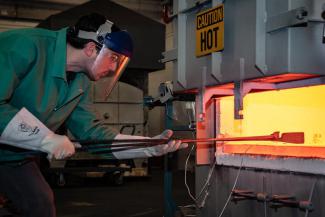In 2021, NETL’s Materials Engineering & Manufacturing (MEM) researchers advanced multiple discoveries, which included developing cost-effective materials to withstand extreme service environments in tomorrow’s highly efficient power plants, removing contaminants from water, finding new uses for carbon wastes, and helping the nation achieve its decarbonization goals while ensuring robust supplies of affordable energy and creating jobs for American workers.
Notable MEM research achievements in the past year were:
- The research team behind the development of Multi-functional Sorbent Technology (MUST) earned a prestigious R&D 100 Award for its game-changing suite of low-cost, versatile sorbents that is highly effective in cleaning contaminated waterways and removing metals from electronic and pharmaceutical production processes. The sorbent particles also can be deployed into a variety of configurations to remove lead from drinking water and treat stagnant water sources such as settling ponds contaminated by runoff.
- Researchers collaborated with Oregon State University and Pacific Northwest National Laboratory to explore how high-temperature carbon dioxide (CO2) degrades power plant materials. The effort bolsters the development of supercritical CO2 power plants to help decarbonize the nation’s power sector. This promising approach is investigating the use of CO2 in place of steam to drive a turbine and produce electricity.
- NETL developed a modified casting method that resulted in a cast version of the nickel-based superalloy 740H to have comparable creep performance to wrought (i.e., forged) versions of the alloy. Many large components for clean energy systems will be produced through casting, and the demonstration of the cast version of the nickel-based superalloy 740H provides alloy options for high-temperature applications.
- Researchers advanced technology to use novel iron-based catalysts for conversion of CO2 to produce valuable gases such as carbon monoxide (CO) or syngas in the presence of fuel (e.g., biomass, coal, methane) for commercial and industrial applications while reducing greenhouse gas emissions. Applications include the production of CO to use as a chemical precursor for high-value products.
- Technology developed by NETL focused on using new catalysts to convert CO2 into formic acid, a simple combination of hydrogen (H2) and CO2. Formic acid can function as a liquid H2 carrier that is easier to store and transport than compressed H2 gas. Finding new ways to create and transport H2 is important because, when consumed in a fuel cell, H2 produces water, electricity and heat, making this clean-burning energy source a critical part of the nation’s clean power generation strategy, with uses across a broad range of applications.
- NETL collaborated with Carnegie Mellon University to make faster and more accurate predictions on the properties of heat-resistant alloys and develop cost-effective, corrosion-resistant materials needed in flexible energy systems. Researchers applied computer vision — technology in which a computer can extract, analyze and understand useful information from an image or a sequence of images — to create quantitative representations and apply machine learning methods to predict material properties.
- Led by NETL, the U.S. Department of Energy Office of Fossil Energy and Carbon Management eXtremeMAT national laboratory consortium continued to leverage high-performance computing power, advanced manufacturing, in-situ characterization and performance assessment in an integrated, collaborative and coordinated effort to address the materials challenges associated with advanced energy systems. The eXtremeMAT team has developed several data- driven models that improve the capability to predict alloy performance in harsh power generation environments.
- NETL researchers invented a high permeance, chemically and thermally stable porous polymer support to serve as the substrate for a CO2-selective membrane for use in industrial carbon capture or other membrane-based carbon capture applications. When the support was coupled with a new selective polymer, also developed by NETL, to make a thin film composite membrane, gas separation performance exceeded any commercially available membrane product.
- Partnering with the University of Pittsburgh, NETL researchers successfully demonstrated a first-of-its-kind embedded multiple distributed fiber optic sensor into a planar solid-oxide fuel cell (SOFC) array to achieve a previously unattainable degree of spatial resolution in temperature measurement inside these high-temperature systems. The effort will enable SOFC designers to eliminate hot spots and better understand failure modes to increase system lifetime and improve overall performance.
These accomplishments are a glimpse into the work the lab is doing through its Materials Engineering and Manufacturing competency to help solve the nation’s toughest energy challenges, such as achieving net-zero carbon emissions in the electric sector by 2035 and the broader economy by 2050.
NETL is a U.S. Department of Energy national laboratory that drives innovation and delivers technological solutions for an environmentally sustainable and prosperous energy future. By leveraging its world-class talent and research facilities, NETL is ensuring affordable, abundant and reliable energy that drives a robust economy and national security, while developing technologies to manage carbon across the full life cycle, enabling environmental sustainability for all Americans.




